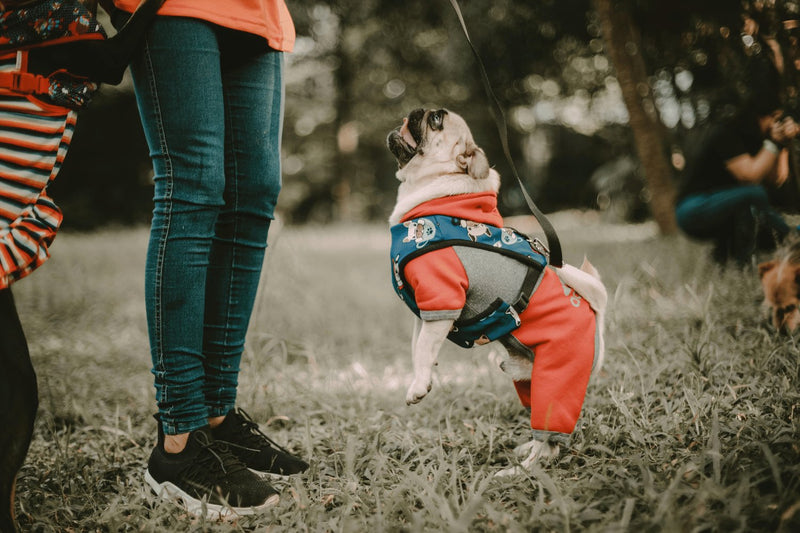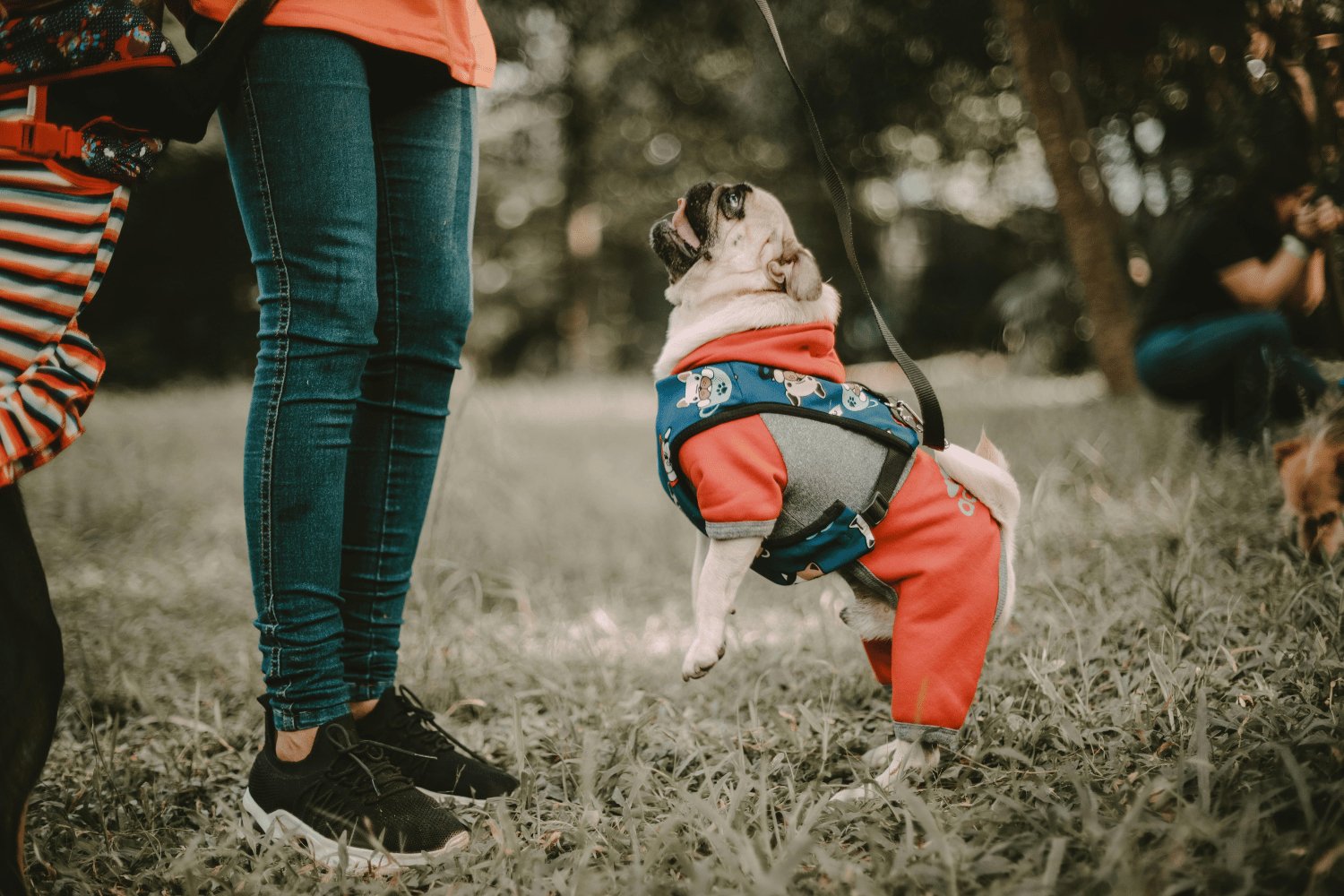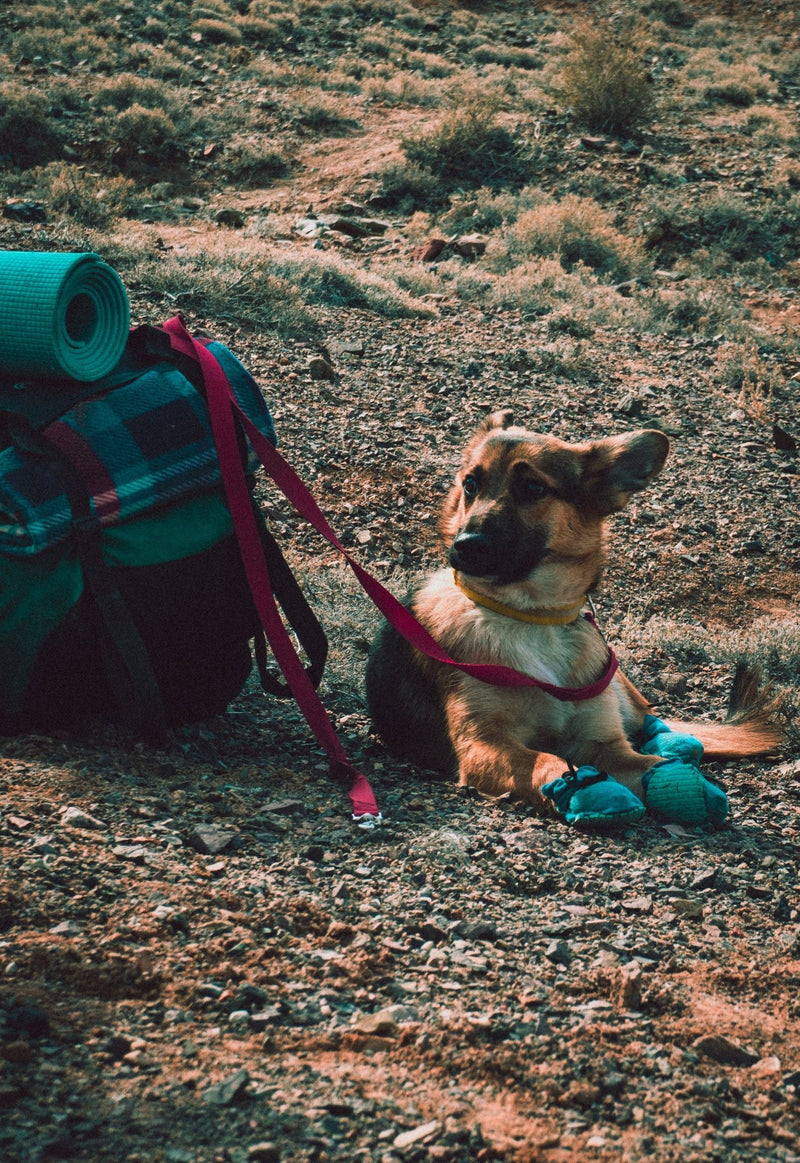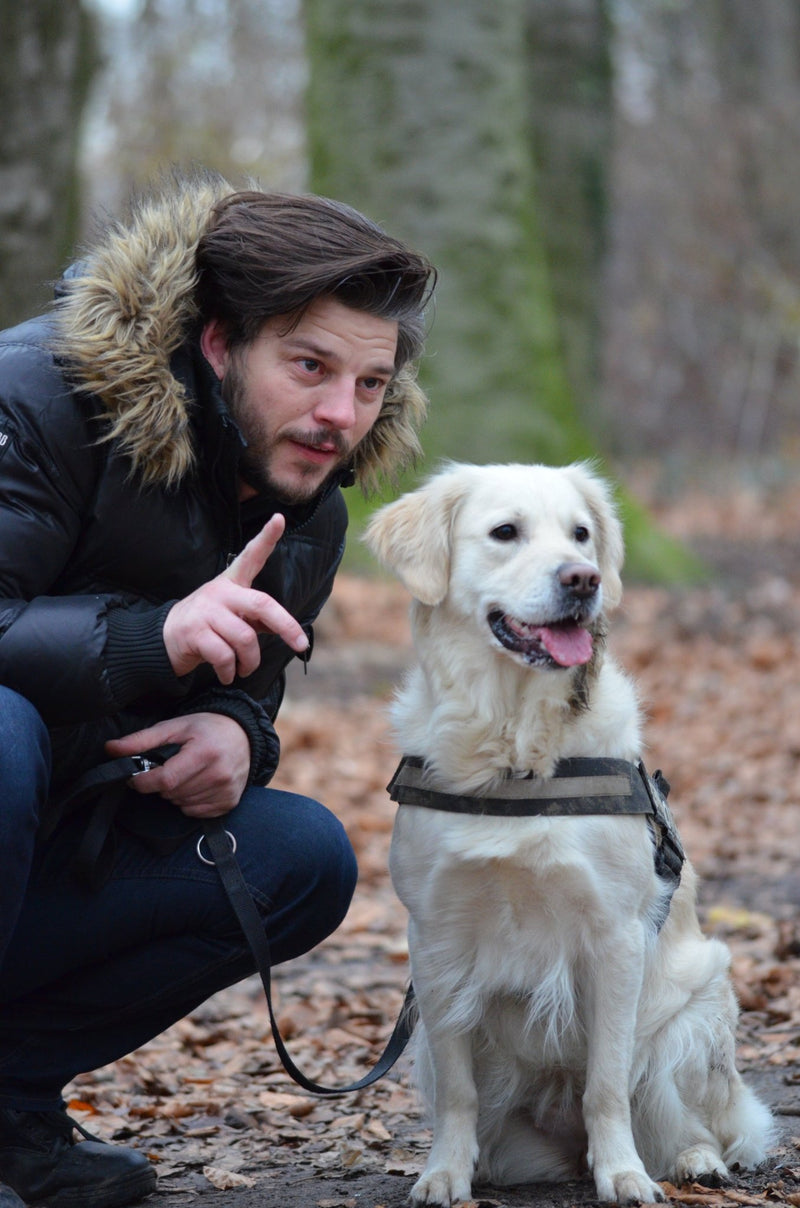
Hey there, fellow dog enthusiast!
Ever find yourself cringing as your dog launches into their signature move of jumping up on everyone they meet? It can be a bit of a buzzkill, right? Picture this: your guests walking in, and instead of a tail-wagging welcome, they get a face full of furry enthusiasm. Awkward, to say the least.
But fret not, because I've got the inside scoop to help you and your pup tackle this jumping-up habit head-on. In our down-to-earth guide, we'll unravel the mysteries behind why dogs do the whole "vertical greeting" thing and arm you with practical training techniques that actually work.
From decoding the secret language of dog jumps to weaving in positive reinforcement methods, we're about to embark on a journey that'll transform your dog's etiquette.
Whether you're a rookie in the dog owner game or you've been battling these gravity-defying antics for a while, this guide is your golden ticket to a more civilized canine companion.
No more cringe-worthy jump scares, my friend! It's time to replace those heart-stopping moments with calm, collected greetings.
Join me, and let's kick off the journey toward a dog-human relationship that's not just harmonious but downright delightful. Your well-mannered pooch awaits – let's dive into this adventure together!
Table of content

Understanding why dogs jump up
When your dog leaps up on you or others, it's crucial to realize they're not trying to be impolite or assert dominance. There are various reasons behind this behaviour, and it's important to uncover the root causes in order to effectively discourage it.
One common motivation for dogs to jump up is the desire for attention. They've learned that jumping can grab our focus and lead to affectionate interactions. Additionally, jumping may indicate excitement or anxiety. Dogs might leap when they're overstimulated or nervous, using it as a way to release pent-up energy or alleviate stress.
A lack of proper training and boundaries also contributes to jumping up. Dogs need consistent guidance on acceptable behaviour. Without clear instruction to keep their paws on the ground, they may default to jumping up as a greeting.
To discourage jumping effectively, it's crucial to address the underlying causes. Understanding why your dog jumps allows you to tailor your training techniques, fostering effective communication and establishing appropriate boundaries with your furry friend.
The negative effects of dog jumping up
Jumping up might seem innocent at first, but it brings potential harm to both your furry friend and those around them. Recognizing the adverse effects of this behaviour is vital in prompting us to take action promptly.
To begin with, there's a physical risk involved, particularly for children or seniors. The forceful jumps from dogs can easily throw people off balance, leading to falls and possible injuries.
Moreover, dogs with long nails may inadvertently cause scratches or bruises while enthusiastically jumping, resulting in pain and discomfort.
Beyond the physical aspect, allowing your dog to jump up can create social awkwardness and embarrassment, especially when they inappropriately greet guests.
This behaviour may give off the impression that your dog lacks discipline or proper manners, potentially straining relationships with friends, family, or even strangers.
What's more, permitting your dog to continue jumping up may reinforce other undesirable habits, such as counter surfing, begging, or even aggression. By addressing the jumping issue head-on, you lay the groundwork for tackling and preventing a range of unwanted behaviours.
In conclusion, dog jumping up carries both physical and social consequences, contributing to the development of other undesirable habits. Taking steps to discourage this behaviour not only ensures a safer environment but also fosters a more enjoyable interaction between your dog and the people they encounter.
Training techniques to discourage dog jumping up
Now that we've delved into why dogs jump up and the potential negative consequences, let's explore effective training techniques to steer them away from this behaviour.
Through consistent implementation of these methods, you can set clear boundaries and establish effective communication with your furry friend, discouraging the habit of jumping up.


Positive Reinforcement Training Methods
Positive reinforcement stands out as a highly effective approach, emphasizing the reward of desired behaviours rather than the punishment of unwanted ones.
Identify alternative behaviours you'd like your dog to display instead of jumping up, such as calmly sitting when greeting people. Promptly reward these desired behaviours with praise, treats, or playtime, creating a positive association that encourages your dog to repeat them and discourages jumping up.
Consistency in rewarding the preferred behaviour and avoiding inadvertent reinforcement of jumping is crucial for successful training.
Setting Boundaries and Consistent Training
Establishing clear boundaries plays a vital role in discouraging dog jumping up. Dogs thrive on consistency and structure, so it's essential to communicate what is deemed acceptable behaviour.
Teach your dog a reliable greeting behaviour, like sitting or standing calmly, and practice it in various environments with increasing distractions.
Consistency is key across all household members to avoid confusion and help your dog understand expectations. When your dog attempts to jump up, calmly redirect their behavior with a command and reinforce the desired behavior with praise or rewards.
Redirecting Your Dog's Behavior
Redirecting your dog's behavior proves to be another effective technique. Instead of scolding, offer an alternative behaviour when your dog jumps up.
Turn away and cross your arms, signalling that jumping up won't achieve what they want. Once all four paws are on the ground, reward them with praise or treats. Consistency is crucial in redirecting behaviour, requiring patience and persistence. With time, your dog will learn that alternative behaviours lead to more positive outcomes than jumping up.
By combining consistent positive reinforcement, clear boundaries, and effective redirection, you'll guide your dog toward understanding and adopting more desirable behaviors.
Positive reinforcement training methods
When it comes to putting an end to dog jumping up, your most effective approach lies in positive reinforcement training methods.
These techniques center around acknowledging and rewarding the behaviours you desire, steering away from punishing unwanted actions. Through positive reinforcement, you can establish clear communication with your dog, fostering more suitable greetings.
An impactful method involves rewarding your dog with treats or praise when they maintain a calm demeanour, keeping all four paws on the ground during greetings. This positive reinforcement creates a connection between staying grounded and receiving rewards. Consistency is crucial; be sure to reward your dog each time they greet someone without resorting to jumping up.
Another valuable positive reinforcement technique involves clicker training. Associating the sound of a clicker with a reward allows you to precisely mark the moment your dog displays the desired behaviour. For instance, when your dog greets someone without jumping up, use the clicker and promptly offer a treat.
This method helps your dog grasp which behaviour is being rewarded and reinforces the notion that jumping up is not desirable.
It's essential to keep in mind that positive reinforcement revolves around applauding good behaviour rather than penalizing the bad. By consistently applying these training methods, you can effectively dissuade your dog from jumping up and encourage them to greet people in a more polite manner.

Setting boundaries and consistent training
Beyond positive reinforcement, the establishment of boundaries and consistent training plays a pivotal role in dissuading dog jumping up. Dogs thrive on the predictability of rules and clear communication, making it crucial to set and uphold expectations right from the beginning.
An effective method for setting boundaries involves creating a designated "no-jumping zone" around you and your guests. This can manifest as a physical boundary, like a designated mat or area where your dog is forbidden to jump up. Whenever your dog attempts to leap, gently guide them back to the ground and redirect their attention to the specified zone. Over time, they'll grasp that jumping up is not permissible within this designated boundary.
Consistency is the linchpin of successful dog training. It's imperative that everyone in your household adheres to the same rules and employs consistent training techniques. Mixed signals from different family members can confuse your dog and impede their progress. Consistency also entails regular practice of training techniques and reinforcing the desired behaviour every time your dog greets someone without resorting to jumping up.
It's essential to recognize that setting boundaries and consistent training go hand in hand. By clearly defining boundaries and unwaveringly reinforcing them, you can effectively discourage your dog from jumping up, fostering a more harmonious environment for both you and your beloved furry companion.
Redirecting your dog's behaviour
Redirecting your dog's behaviour stands out as another effective technique for discouraging jumping up. Instead of relying on a simple "no" or pushing them away when they jump up, guide their attention towards an alternative behaviour that is more suitable.
A practical approach to redirection involves teaching your dog an alternative greeting, like sitting or offering a paw. Instruct your dog to sit or extend a paw when they approach someone, replacing the instinct to jump. Reward them with treats and praise for executing the alternative greeting correctly. This not only discourages jumping up but also provides your dog with a socially acceptable way to interact with people.
Another technique involves redirecting your dog's energy through physical activity. Prior to the arrival of guests, indulge your dog in an energetic play session or take them for a brisk walk. By expending excess energy, your dog becomes less prone to jumping up out of excitement when someone arrives. Introducing mental stimulation through puzzle toys or training exercises can also redirect your dog's focus and deter them from jumping up.
Remember, the process of redirecting your dog's behaviour demands patience and consistency. By offering alternative behaviours and redirecting their energy, you can effectively discourage jumping up and impart to your dog more suitable ways to greet people.
Using commands and cues to discourage jumping up
In my experience, I've found that commands and cues play a crucial role in steering my dog away from the habit of jumping up. Teaching specific commands and cues allows for effective communication of expectations and redirection of their behaviour.
A key command that has worked well for me is the "off" command. This prompts my dog to either step down or keep their paws on the ground. I began by using treats to guide my dog into a sitting position, followed by saying "off" and rewarding them when they complied. Through consistent practice, I gradually phased out the treat lure, emphasizing rewards solely for responding to the verbal command.
Another useful cue involves incorporating a visual element, such as turning my back or crossing my arms when my dog tries to jump up. The act of withdrawing attention and physical contact sends a clear message that jumping up is not acceptable. Once my dog has all four paws on the ground, I turn back around and reward them with attention and praise.
From my personal experience, I can't stress enough how crucial consistency is when using commands and cues. Regular practice of these techniques and reinforcement of the desired behaviour every time my dog responds appropriately have been key. Over time and with consistent training, my dog has learned to associate these commands and cues with not jumping up and responds accordingly.

Training tools and equipment to aid in discouraging jumping up
In my journey with my furry companion, I've discovered that, besides training techniques, there's an array of tools and equipment available to lend a helping hand in discouraging dog jumping up. These tools have proven to be invaluable in providing extra support and reinforcing my training efforts.
One tool that has made a difference for us is the front-clip harness or head halter. These gear options offer greater control over my dog's movements, redirecting their attention and discouraging jumping up. When my dog attempts to leap, I gently guide their head or body using the harness or head halter, effectively interrupting the jumping behavior and encouraging them to stay grounded.
Another practical tool in our toolkit is a portable mat or blanket that I bring along when visiting friends or family. Teaching my dog to associate the mat or blanket with calm behavior involves rewarding them when they choose to lie down on it. Upon arriving at a new location, I lay out the mat or blanket, prompting my dog to settle down. This creates a designated spot for relaxation, preventing any impulse to jump up on people.
I've learned that it's important to view training tools and equipment as aids rather than substitutes for proper training techniques. Seeking guidance from a professional trainer or behaviorist ensures that these tools are used correctly and effectively in harmony with the overall training plan.
Common mistakes to avoid during training
When you're teaching your dog not to jump up, it's crucial to be mindful of common errors that might slow down your progress. Steering clear of these pitfalls will keep you on the right path and bring about better outcomes.
One common mistake is accidentally reinforcing the jumping up behaviour. There are times when giving attention or physical contact unintentionally can encourage your dog to keep jumping. Ensure that you only reward and show affection when your dog remains calm with all four paws on the ground. Consistency is key – avoid sending mixed signals and be conscious of reinforcing the desired behaviour.
Another misstep is resorting to punishment or harsh corrections. Using physical punishment or raising your voice can instil fear and anxiety in your dog, potentially leading to more behavioural issues. Instead of focusing on punishing unwanted behaviour, concentrate on rewarding the behaviour you want and redirecting your dog's attention toward more appropriate actions.
Keep in mind, training takes time and patience. Consistency and positive reinforcement are the foundations of success. By steering clear of common mistakes and staying committed to positive training methods, you'll effectively discourage jumping up and foster a more harmonious relationship with your furry friend.
Conclusion: Celebrating progress and maintaining consistency
Hooray! You've made it to the end of our ultimate guide on curbing dog jumping. By incorporating the training techniques and strategies we've shared, you're well on your way to having a more well-behaved and courteous furry friend.
Remember, training is a journey that requires time and consistent effort. Celebrate each small triumph along the way and be patient with your dog. Just like Rome wasn't built in a day, a well-trained pup takes time to shape. With dedication and persistence, you'll soon notice that jumping up becomes a thing of the past.
Maintaining consistency is the key to long-term success. Keep practicing the training techniques regularly and reinforce the desired behaviour every time your dog greets someone without jumping up. Over time, your dog will internalize these lessons and understand that jumping up is not acceptable.
Bid farewell to those routine jump scares and welcome a more harmonious relationship with your four-legged companion. Armed with the knowledge and tools from this guide, you now have the ability to kickstart your training journey and mould a more well-mannered pooch.
So, what are you waiting for? Dive into implementing these strategies today and relish in the joys of having a dog that comprehends jumping up is a big no-no. Here's to a happier and more well-behaved canine companion!





